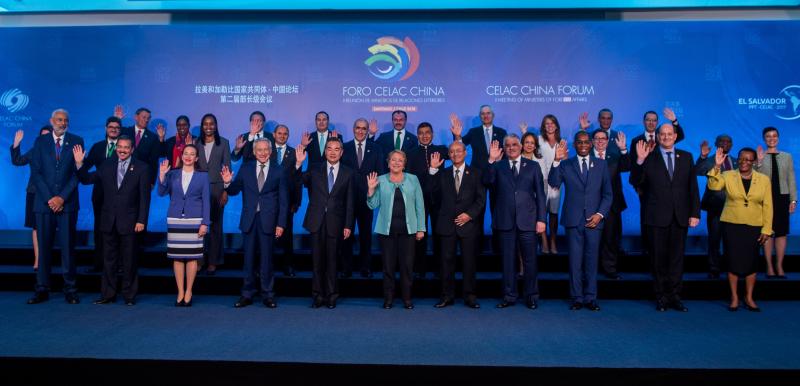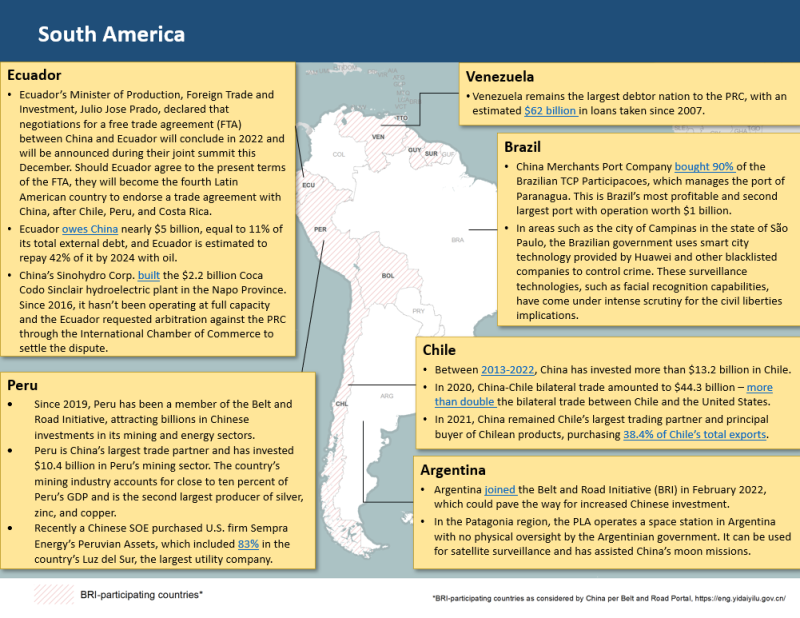The Rise of Chinese Influence in Latin America

By: Ella Meyer, CLAS student intern, Spring 2023

In 2013, China announced the creation of its Belt and Road Initiative (BRI), also known as One Belt One Road or the New Silk Road. BRI is a global initiative designed to connect East Asia and Europe through physical infrastructure. There are five main priorities outlined in BRI: policy coordination, infrastructure connectivity, unimpeded trade, financial integration, and connecting people. Later that year, China’s President Xi Jinping announced the 21st Century Maritime Silk Road which expanded BRI to Africa, Oceania, and Latin America. As of January 2023, 151 countries have either signed on to BRI projects or expressed an interest in doing so, with 15 out of 23 countries in Latin America having signed onto the initiative.
The increase in Latin American countries joining BRI, the BRICS group of nations (named for its founding members of Brazil, Russia, India, China, and South Africa), and the China-led Asian Infrastructure Investment Bank (AIIB), which invests in infrastructure in its partner countries around the world, show the growing strength of China-Latin America relations and the commitment to future investment and trade. In 2021, Argentina and Chile joined the AIIB, while Peru joined in January 2022.
Supporters have lauded the BRI as increasing economic partnerships, trade, and investment flow in its member countries. However, its opponents criticize the lack of transparency, its harmful effects on the environment, and the unstable debt risk that its participants take on. The BRI loans are at market rate interest and China expects to be paid in full and can demand repayment at any time. Many BRI countries are experiencing debt crises due to their inability to repay the loans. This gives China leverage to push their political agenda, like with the treatment of Uyghurs, a minority in China who have been subjected to human rights violations like forced labor, mass sterilization, internment camps, etc, or recognition of Taiwan. After Chinese investment, Panama, Nicaragua, and El Salvador broke diplomatic ties with Taiwan. Latin America is essential for Taiwan’s ability to maintain its sovereignty as eight of Taiwan’s fourteen remaining diplomatic partners are in the region. If China continues to pressure Latin American countries with trade deals and investments in exchange for revoking recognition of Taiwan, the country may soon become isolated on the global stage.
China has an extensive record of investments in Latin America. The most notable are highlighted below.

China is currently South America’s largest trading partner and its activity in the region is increasing exponentially. The most notable projects are Chinese investments in Peru’s mining sector and the hydroelectric plant in Ecuador.

In Nicaragua, China is in the process of building a canal that will compete with the Panama Canal. Additionally, China has created six special economic zones in El Salvador that covers 14% of the country and prohibits any American and European investments, businesses, or trade.

China is a major trading partner of Cuba and has invested heavily in Cuba’s tourism, mining, telecommunications, and energy sectors. Cuba also plays a key role for China’s ability to project its power in the region.
China’s activity in Latin America is focused on building “new infrastructure”: 5G, electricity, transmission, high-speed rail, electric vehicles, data centers, and artificial intelligence. Beijing has invested heavily in the ‘lithium triangle’ which is located in Argentina, Bolivia, and Chile and accounts for 56% of the world’s lithium resources. In Peru, China is the largest investor in the mining sector and controls seven of Peru’s largest mines, 100% of Peru’s iron production, and 25% of the copper output. Also, many Latin American countries have bought Chinese facial recognition technology and depend on the Chinese company Huawei’s 5G cellular towers despite the national security and personal data risk (Huawei is required to provide China’s intelligence agency with information on its users’ information when requested).
China has strengthened its presence in Latin America for a multitude of reasons. First, Latin America has an abundance of natural resources and raw materials that China can use to meet its massive demand for crude oil, iron, and copper. Second, amid rising concerns over Chinese food security, Latin America’s agricultural goods are crucial for China; Brazil and Argentina are two of China’s largest soybean and oilseed exporter. Third, Latin America has a large population and geographical area which offers a large market for Chinese electrical, mechanical, and high-tech products.

Latin America’s growing partnership with China is a shift from the region’s historically strong relationship with the United States. Congress has proposed multiple bills to counter China’s influence in the region, but none have passed. In late January, Biden announced negotiations with 11 mostly Latin American nations on an agreement that would promote regional economic cooperation. However, it’s unclear whether the agreement will have a significant impact since the initiative is based on broad proposals, rather than concrete economic action. Biden has repeatedly expressed his desire to increase US partnership with the region but a growing opposition at home has significantly hindered his capabilities.
Many Western states have expressed concern over China’s sale of military equipment to Latin American states. Venezuela, Ecuador, Bolivia, and Argentina have purchased Chinese defense equipment and engaged in joint military exercises and training for military personnel. From 2009-2019, China sold more than $600 million worth of arms to Venezuela alone and transferred tens of millions of dollars' worth of military equipment to Bolivia, Argentina, Ecuador, and Peru.
The partnership between China and Latin America continues to grow rapidly with trade expected to double by 2035 and reach more than $700 billion a year. The region is expected to become the site of a geopolitical competition between China and the US over trade and influence. China’s growing presence will have major implications not just for the region and the United States, but other Western nations and Taiwan.
Points to Consider:
- What are the long-term implications of Latin America’s growing relationship with China?
- How will China’s weapon sales to Venezuela affect the country’s domestic and international politics?
- Is the era of American influence in the region coming to an end?
Suggested Reading:
- https://www.cfr.org/backgrounder/chinas-massive-belt-and-road-initiative
- https://www.cfr.org/backgrounder/china-influence-latin-america-argentina-brazil-venezuela-security-energy-bri
- https://blogs.eui.eu/latin-american-working-group/the-belt-and-road-initiative-in-latin-america-how-china-makes-friends-and-what-this-means-for-the-region/#:~:text=There%20are%20five%20major%20priorities,a%20topic%20of%20heated%20debate
